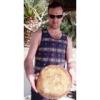
Some Variations on Hamelman's "80% Sourdough Rye with a Rye-Flour Soaker"
I have made this bread before, and posted on it here: http://www.thefreshloaf.com/node/17539/slight-variations-two-more-formulae-hamelman039s-quotbreadquot
The original formula can be found in:
Hamelman, J. [2004] "Bread: A Baker's Book of Techniques and Recipes" New Jersey: John Wiley and Sons pp. 213 - 214
Changes I introduced this time round:
- The rye sour is made in the proportions of flour and water most familiar to me. An 18 hour ferment of the second elaboration of the sour followed a 6 hour fermentation time of the first elaboration.
- The formula includes both Caraway Seeds and Organic Blackstrap Molasses.
- As with my earlier version, no fresh yeast is used in this formula.
- The overall hydration is 85%, increased to satisfy the very thirsty coarsely ground Bacheldre Stone ground Organic Dark Rye Flour. In future, I would keep this level of hydration, but would add water at 25 to the soaker, rather than 20; this means no water would be needed in the final dough.
- The loaf is topped with Blue Poppy Seeds, but still baked with the lid on the pan.
Makes One Large Loaf in a Pullman Pan
|
Material |
Formula [% of flour] |
Recipe [grams] |
|
1. Rye Sour Dough |
|
|
|
Dark Rye Flour |
36 |
360 |
|
Water |
60 |
600 |
|
TOTAL |
96 |
960 |
|
2. Soaker |
|
|
|
Dark Rye Flour |
20 |
200 |
|
Boiling Water |
20 |
200 |
|
TOTAL |
40 |
400 |
|
3. Final Dough |
|
|
|
Rye Sour Dough [from above] |
96 |
960 |
|
Soaker [from above] |
40 |
400 |
|
Dark Rye Flour |
24 |
240 |
|
Strong White Flour |
20 |
200 |
|
Salt |
1.8 |
18 |
|
Caraway Seeds |
1.8 |
18 |
|
Organic Blackstrap Molasses |
4 |
40 |
|
Water |
5 |
50 |
|
TOTAL |
192.6 |
1926 |
|
% Pre-fermented Flour |
36 |
|
|
Overall Hydration |
85 |
|
Method:
- Build the sourdough using the elaborations described above, and make the soaker at the same time as the final elaboration. Cover both and leave overnight.
- Add the water, salt, caraway seeds and molasses to the sourdough. Break up the soaker into pieces and add this using a mixer with beater attachment to break up the soaker properly. Add the flours and mix either with a machine using a beater attachment, or use wet hands to mix the paste until it is "clear".
- Ferment in bulk for half an hour. Meanwhile prepare the Pullman Pan, lining it with silicone paper.
- Shape using wet hands, and drop the mixture into the pan, and smooth the paste neatly. Brush the top with a little water and cover with Blue Poppy Seeds. Prove for 3 to 4 hours at 28°C, with the tin covered with plastic sheet, or, cling film. The paste should be just short of the top of the pan.
- Pre-heat the oven to 170°C, with a pan of water in the base for steam. Cut the top of the loaf with 4 diamonds*, then put the lid on and bake the loaf for 2½ hours, turning the tin halfway through and topping up the water pot if necessary.
- De-pan the loaf, and check for an internal temperature of at least 96°C.
- Cool on wires
* You can see Hamelman uses this method for one of his rye loaves in the lovely photo between pages 224 and 225. I needed to cut deeper, but am not sure this was possible. My loaf being baked with the lid on meant the crown of the loaf had not passed the top of the tin. Clearly, the seed-topped loaf in the photo in the book is made in a pan without a lid.
Alison and I just sneaked a wee taste, although the bread is still somewhat "young". There is a definite sour taste, and the bittersweetness from the molasses is also evident. That unique flavour from Caraway brings greater complexity still. It is so very moist, perhaps just a little too moist, but that will settle very quickly. The flavour lingers long in the mouth...yum!
All good wishes
Andy
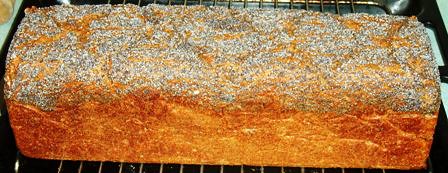
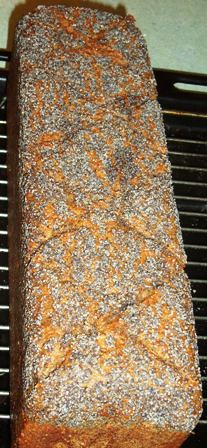
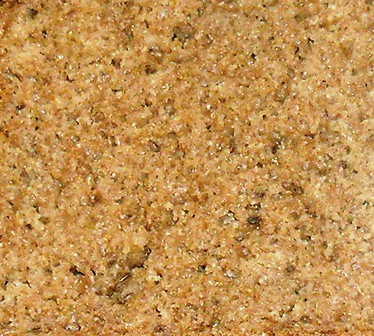

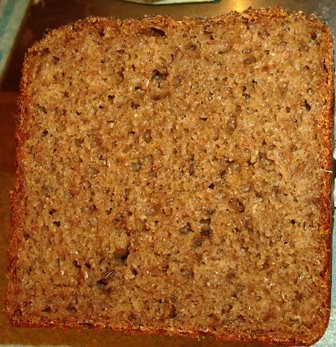


Comments
Hi Daisy_A.
That's what it takes to fill a Pullman Pan with Rye paste.
Plan is to take some to the "in-laws" on Tuesday. All the family was coming here, but the weather put the kybosh on that.
I hear it's hitting the Eastern US now.
Think I may now have missed you as you dip in and out of TFL so briefly just at the mo'.
All good wishes
Andy
I'm going to use my pullman pan for the first time this week.
Most of Hamelman's rye formulas make about 3.5 lbs of dough for the "home" batch. However, he generally specifies 4.5 lbs of dough for baking in a 13" Pullman pan.
Is there any harm in baking the smaller amount in the pullman pan, or would you recommend scaling up the dough to fill the pan?
David
Hi Andy,
Like you, I've always admired that loaf you refer to in 'Bread' and have wanted to try my hand at it for some time now. Your version of it looks excellent and definitely one I'll be referring to when the time comes to do my own mix of it. I'm wondering if you had any difficulty in maintaining the DDT of 82F with the ambient you mentioned in recent posts. I like the addition of molasses and poppy seeds you made, but for myself I'd have to leave out the caraway.
Is the photo in the book a seed topped loaf? To my eyes it looks like it's flour dusted, even when I put my glasses on. Regardless, both yours and Hamelman's loaves are spectacular, seeds or not.
Happy Holidays!
Franko
Hi David,
A less than full pan gives a loaf which looks stunted, and is, dareIsay, "disappointing"?
You could work on 1.7kg as a minimum High Rye to fill one of those lovely Pullman Pans. I reckon thats about 3 and 3/4lb. So you need to be upscaling, really.
BTW, your posts on SFBI etc made me realise i need my own copy of Advanced Bread and Pastry. Fortunately, I can get it cheap as an Instructor...job number one when I get back to work
BW
Andy
I'll fire up my "Dough Maker" spreadsheet and calculate for 2 kg of dough.
I'm going to make the "70 perscent rye with a rye soaker and whole-wheat flour." I have some rye berries. I'm going to try making rye chops from them with a chef's knife.
David
I reckon you'll need to chop 390g Berries, David.
I've never done it myself, but it seems like a hard call; dedication beyond duty, perchance? I hope you discover a good method and look forward to reading about it on your blog post.
If you look at both these recipes and refer to the metric column you can see Hamelman's base is for 10kg of flour in total. This is my first starting point to construct a formula of my own. First of all I convert this metric section so thatl the total flour equals 100, then I balance the rest of the formula from there. Then I decide how much to make and use the Bakers' % to multiply up.
Given I know you want to be faithful to the Hamelman formula, all you need to do is find a divider to take you down from his 19.14 kg dough total to the 2 kg that you want. If you use 9 as a divider that will give you 2.12kg final dough quantity. I avoid Hamelman's home quantities for 2 reasons. Firstly, I'm devout "metric". Secondly, I know this book has been written mainly for professional bakers, and believe the larger quantities would be the ones Jeffrey Hamelman used when compiling his book. I might be wrong on this, and am happy to stand corrected if anyone knows better.
Have fun!
Andy
That was a lot of rye berries to chop, as you said. I tried using a couple methods. A chef's knife on a cutting board sent berries flying everywhere. I ended up using a very old wooden bowl and chopper last used probably 30 years ago by my mother to make gefilte fish (pre-Cuisinart days).
I was not sure that my chopping was adequate, so I decided to use a boiling water soaker for the rye berries.
This laborious experience has prompted me to order the grain mill attachment for my KitchenAid!
I'll post the bread after it's baked.The dough is fermenting now.
David
Good compromise David. I like the idea of applying hot soaking to the multiple grain grinding you achieved.
I think Franko realised you may be heading for a hard time too. Will add comment to your new thread shortly
Thanks
Andy
Hi Franko,
Maybe I need glasses then. I could have sworn I saw Poppy Seeds this morning, but it's clearly a loaf dusted with flour, as you say!!!
Hell, the Dough temp was so difficult this morning. The small amount of water I added was from the boiling kettle. HOWEVER: I'd just stoked up the wood-burning stove during the bulk proof. So, the final proof in the tin brought the paste upto the required temperature reasonably quickly. I guess if I'd had a better dough temperature from the start, proof time would have been a more ideal 3 hours.
I agree, Caraway is an individual taste; I didn't really like it back in the 1980s when I first got into cooking good curries. Now, I find I really appreciate it a lot more.
Many thanks for your kind words
Best wishes
Andy
Well that's relief! I was worried I might have to go and get my prescription re calibrated.
Funny about how we can acquire a taste for something we used to dislike isn't it. That's been the case for me with many foods over the years but every time I give caraway another shot it just doesn't make it for me. I suspect it never will, at least on it's own.
Franko
I have yet to try this recipe, andy, but yours looks fabulous!
No pullman here.
Hi Khalid,
You may have noted that I had to add water to the final dough. The water quantity I used is 7% increased on Jeffrey Hamelman's original recipe.
I'm writing this to show you that the paste I produced was pretty clay-like, and not too soft. A quick look at the photos on my earlier post may also be reasonably insightful, as there is oone of the paste proving here: http://www.thefreshloaf.com/node/17539/slight-variations-two-more-formulae-hamelman039s-quotbreadquot
Of course Rye Flour is notoriously unpredictable when it comes to water absorption, and it is always thirsty if you use wholegrain, as I know you and I both prefer.
But, it would be possible to prove these as "logs" as described in the book, and try to bake them out as "batards" You could prove them on floured "couches" of open-weave linen. You could also try proving them in Bannetons. You would just have to be very careful to use the right material to dust the banneton with in the first place. Dark Rye Flour, plus Coarse Semolina or Rice Cones seems the preferred options as I read it on TFL.
Best wishes
Andy
Thanks for the Tips, Andy. Will try your rcipe someday. Much appreciated